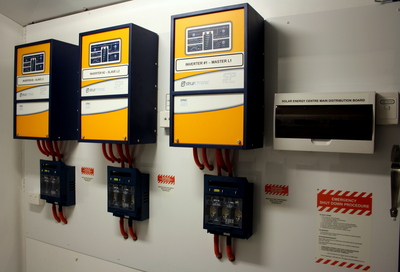Despatchable solar energy
Sunday, 07 April, 2013
Much has been said about the limitations of photovoltaic (PV) solar as an alternative energy source, given its inherent intermittent nature. PV Solar has even been blamed for grid instability as well as pushing up the price of electricity. So what about a solar system that allows the utility to decide how much power it requires and when?
In 2012, Essential Energy contracted LJW Solar to design and construct a solar-generation system with linked storage capacity at the Bega Valley Shire Council Library. The purpose was to test and confirm the benefits and value of deploying a solar-generation plant where output is stable and not as impacted by local environmental variations. An additional requirement was to put power back on the network at times that were more beneficial, and to ultimately facilitate reduction of thermal base-load generation.

Peter Newell from Essential Energy said, “We wanted to produce a reliable and consistent solar energy supply to our network. The bonus for the library is, if a grid outage ever occurs, supply continues from the batteries and solar.” It was required that 15 kW be available to export to the grid for a minimum of 3 h per day.
Selectronic Australia was invited into the project after concerns that the charging processes from the originally sourced AC coupled system, using grid connect inverters and back-up inverters, could not be isolated. This had the potential to impact the customer’s account and possibly interfere with the network by drawing power from the grid at inappropriate times, defeating the purpose of network support.
Ultimately a DC coupled system was chosen, as it best met all aspects of the scope. The Selectronic SP Pro, which is only available via a utility unlock code, was used to allow stored power to feed back to the grid.
Major system components were: 20 kWp array - 108 Suntech 190 W panels mounted on the library roof; grid tied backup inverters - total 15 kW three-phase output, 3 x Selectronic SPMC 481; MPPT charge controllers from solar to battery - 6 x Midnight 150; battery bank - 72 x 1500 AH/2 V gel-plate batteries - 3 strings 48 V nom - 200 kWh nominally.
Selectronic SP Pro inverter chargers provide the necessary functionality. The system functions in four modes:
Solar to grid: this occurs when the batteries have been charged to float. Grid feeding function is triggered from SP Pro.
Battery charging - solar to battery: this is the normal state. All AC load is fed directly from the AC source. All solar power is directly charging the batteries.
Off-grid - grid interruption - grid backup system: when there is significant irregularity, disruption, brown out or complete loss in grid power. This initiates the off grid or island function of the inverter as it seamlessly disconnects from the grid while providing DC power inverted from the battery bank and solar power to continue to run the AC loads. The solar charging function continues if solar power is present.
Battery to grid feeding: when the utility requests. This is an unnatural state for most systems; however, this system has been designed to feed stored solar energy to the grid due to the ability of the SP Pro inverter. This is based on a start and finish time configuration of the inverter. This is currently set automatically to output 15 kW at the same time each day at which time the solar input may or may not be present.

Communication is key to this project and very accurate system performance data can be collected over the internet from the SP Pro inverters. Essential Energy can also make changes at any time to the many system parameters available to them via a secure connection.
There are now further options available which go beyond timed control for energy despatch. Voltage reactive, state of charge and even real-time control are all possible. There are far-reaching implications for inherently intermittent renewable sources like PV solar and wind when it comes to despatchable energy. Renewables being available as smooth, reliable and dependable sources of energy make possible the support of the grid; whether the national grid, or diesel. Applications like peak demand control become highly effective, given the speed and versatility at which this supply of energy can be switched.
Tackling EV misinformation at Everything Electric
Lauren Davis discusses all things EV with Robert Llewellyn, Red Dwarf cast member...
Let's talk about electrification, digitalisation and decarbonisation
Can the building sector use AI tools as a binding force for different energy efficiency processes?
A connected world: how smart systems are enhancing sustainability
The drive for smarter, smoother, more efficient connected and integrated infrastructure is often...




